Laboratory of Plant Breeding
Research Theme




Donkan Ryoku (Low temperature insensitivity) of rice
Rice is a plant of subtropical origin and cold disorder is a major problem in rice cultivation in Hokkaido. Rice is said to be the lowest temperature weakest in the booting stage, two weeks before flowering. Most studies find and introduce resistance genes from the idea that plants respond positively to various stresses to obtain resistance. We discovered an example different from the conventional way of thinking ‘Donkan Ryoku’ (low temperature insensitivity) which shows stress tolerance by not feeling low temperature stress. In addition, lower temperature disorders are effective not only for improving cold tolerance at the booting stage but also at low temperatures from late summer to autumn due to early birth. Therefore, we investigate the relation between photoperiod and temperature condition and growth rate and try to deepen the understanding of adjustment of heading period. (Y. Kurasawa, K. Yamamori, S. Sakaguchi, S. Kikuchi)
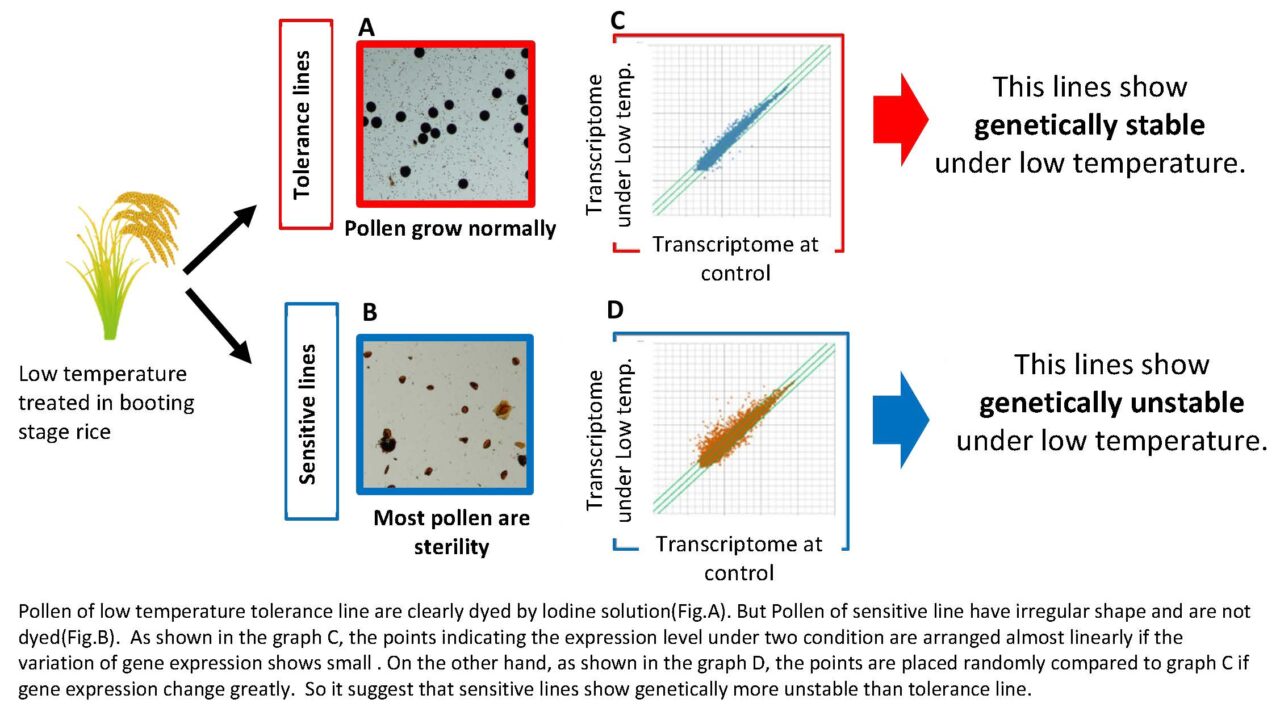
Transposition control of transposon Tam3 in Antirrhinum majus
Transposition of transposons is one of the phenomena creating gene mutation, which is important for plant breeding. In Antirrhinum majus, when the transposon Tam3 transposed from a certain locus, a pigment gene begins to express and the flower colour changes. This transposition is promoted under cold conditions. In our laboratory, we analyze the mechanism by which Tam3 is transposed on the genome. Our final goal is establishing transposons as a new method of plant breeding.
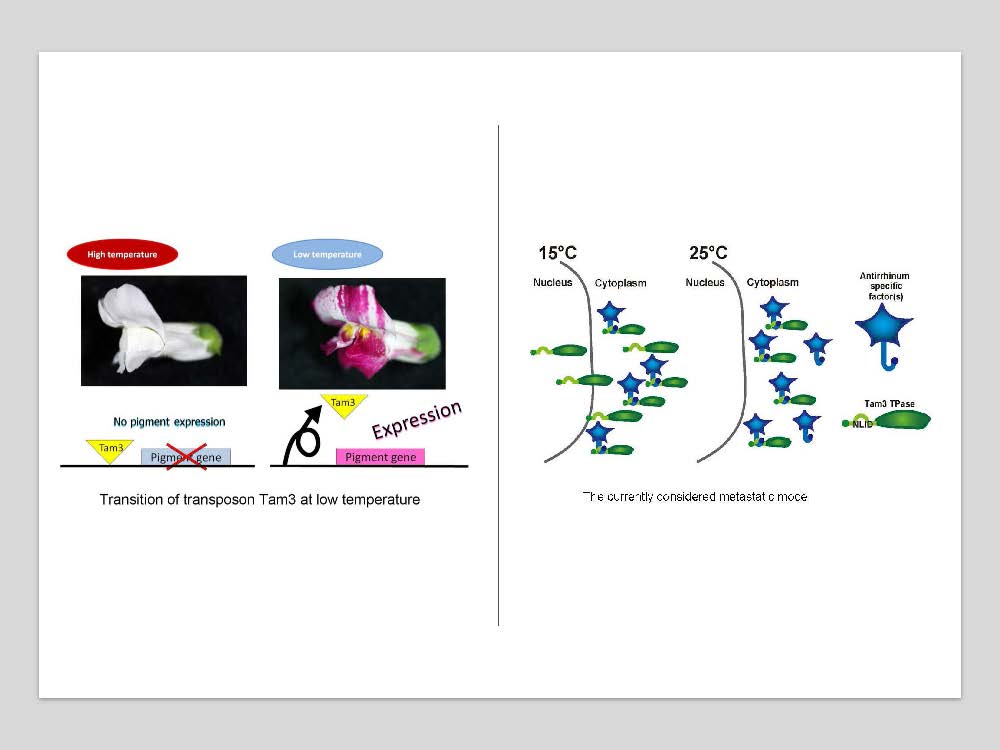
Analysis of regenerated plants and the mechanism of microspore dedifferentiation through anther culture.
Do you know what will happen when culturing rice anthers filled with pollen? Callus (undifferentiated plant cell) appears and grows to regenerated plants. These regenerants have almost similar traits like normal parent plants, but due to somaclonal variations, some of the regenerated plants show some specific characteristics, including albinism and higher ploidy levels. That is why these regenerants are useful as research targets to investigate the plant’s mechanism of reproduction and growing process. Through “anther culture” approach, our team has got successes to produce high ploidy (tetraploids) rice lines and regenerants from sterile F1 hybrids between Asian and African cultivated rice. We have also made efforts to observe meiotic abnormalities of high ploidy rice and uncover the mechanism of callus induction and genotype differences in albinism frequencies.
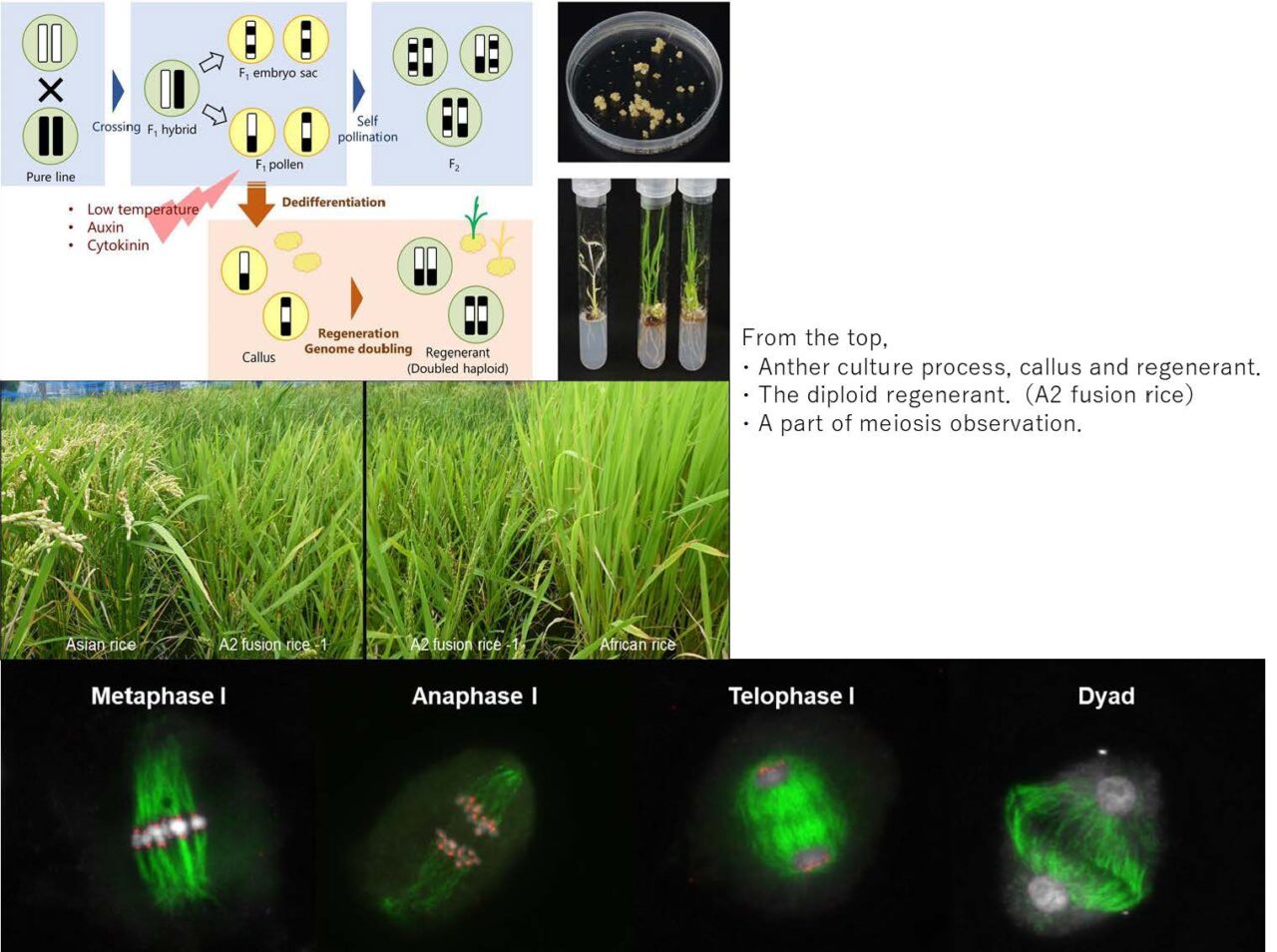
Understanding and Breaking “Reproductive Barriers” in Rice
The species barrier, known as the reproductive barrier, acts to prevent the exchange of genes between species. The barrier also prevents the creation of new crops through interspecific crossing in breeding.
We use hybrid sterility in rice as a model case of the barrier to understand its molecular mechanisms, its evolution, and the way to overcome it. Focusing on the hybrid sterility observed in Asian and African cultivated rice species, we aim to identify the causal genes and create a new allele ,which can avoid the sterility through mutagenesis and genome editing.
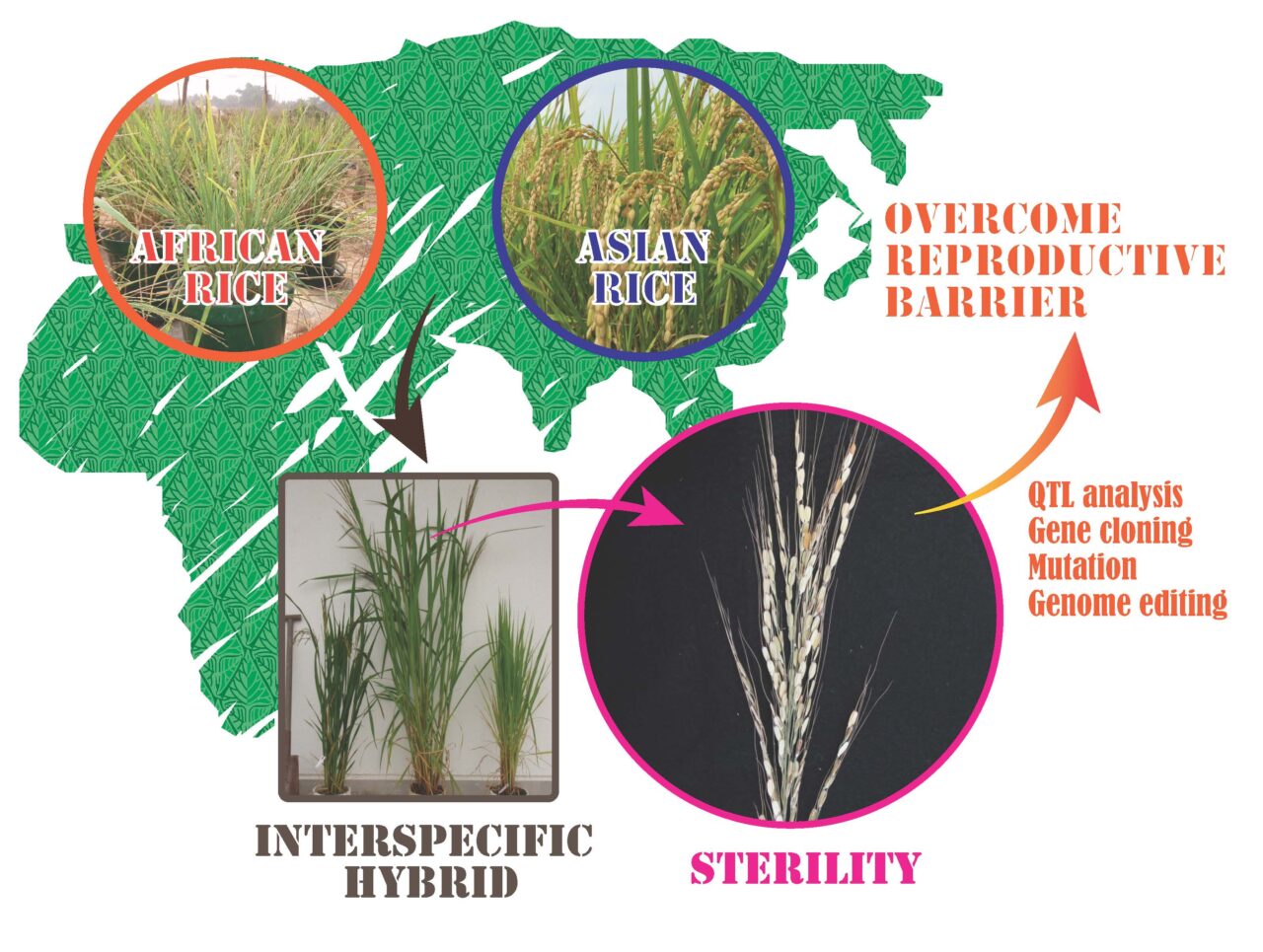
Gene analysis using rice mutant
Mutants are important materials for genetic and breeding research, therefore we induce and select various mutants. In mutants, genes are altered, resulting in loss of gene function or diminished function. By examining these mutants, we will be able to recognize and investigate the gene for the first time.
Rice leaves and spikelets are important traits related to rice yield. Many genes act on these formations. Examining the function of these genes is an important research subject as the basis of breeding, and we are conducting research using various mutants related to rice morphology.
A) A zebra mutant showing leaves with horizontal stripes of chlorosis during the seedling stage in rice. (B) Various malformed spikelets in the progeny of crossing between mutants that cause malformations in the spikelet structure in rice. (C) Testing of mutants with variations in seed size. (D) Cultivation and selection of mutants in paddy fields.
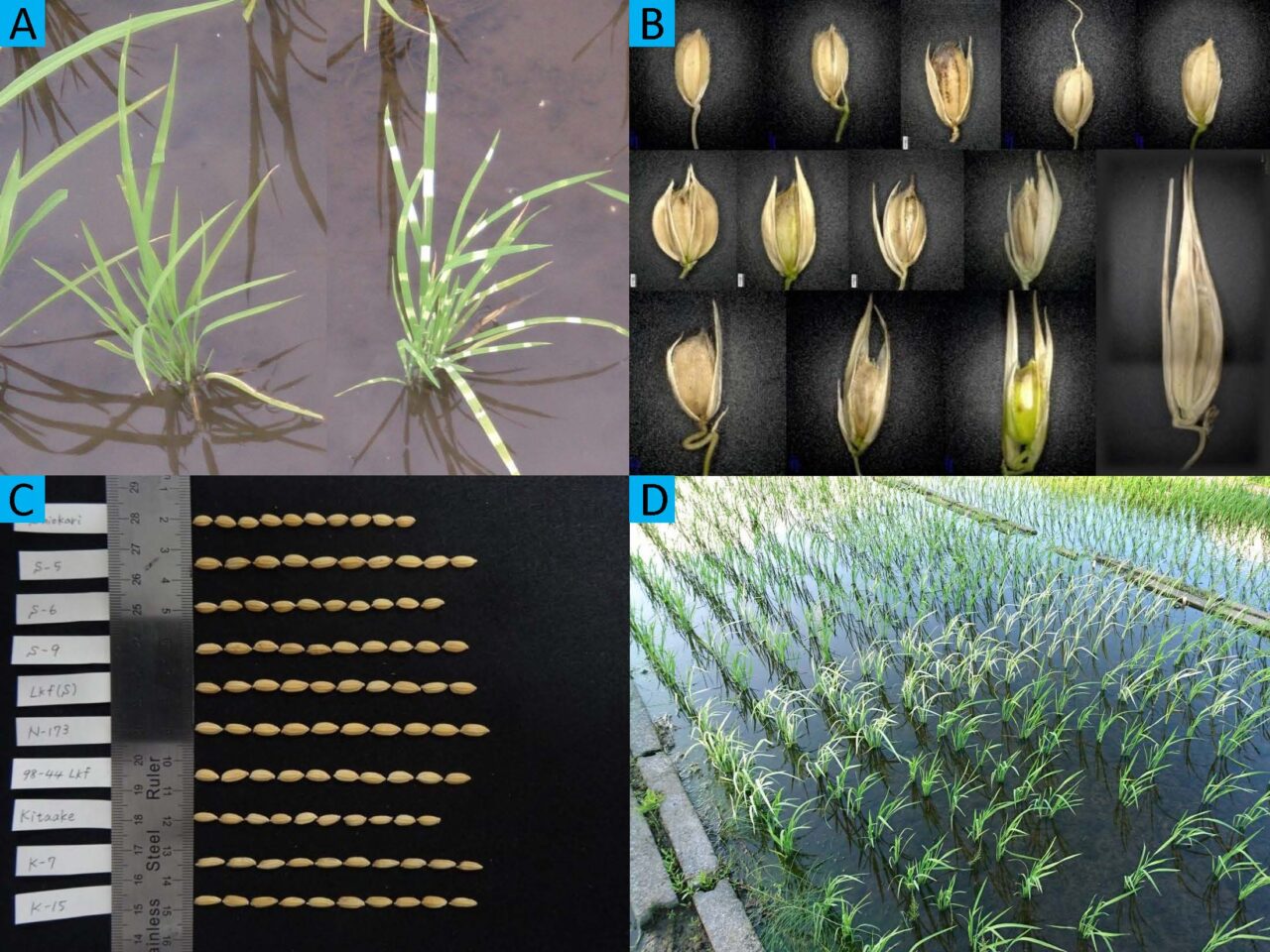
Exploring the Nature of Form and Motion of Plants by Using Computational Models
How are the complex shapes and movements of plants controlled? We use mathematical modeling to reproduce the shape and movement of plants by computer to explore their essential mechanisms. We are also developing a measurement method to understand the shape and movement of plants.
Moreover, we use models to understand phenomena that are impossible to reproduce, such as the evolution of plants.
A variety of crops, such as rice and soybean, are used depending on the individual study. We aim to create new crops based on our understanding of shape and movement mechanisms.
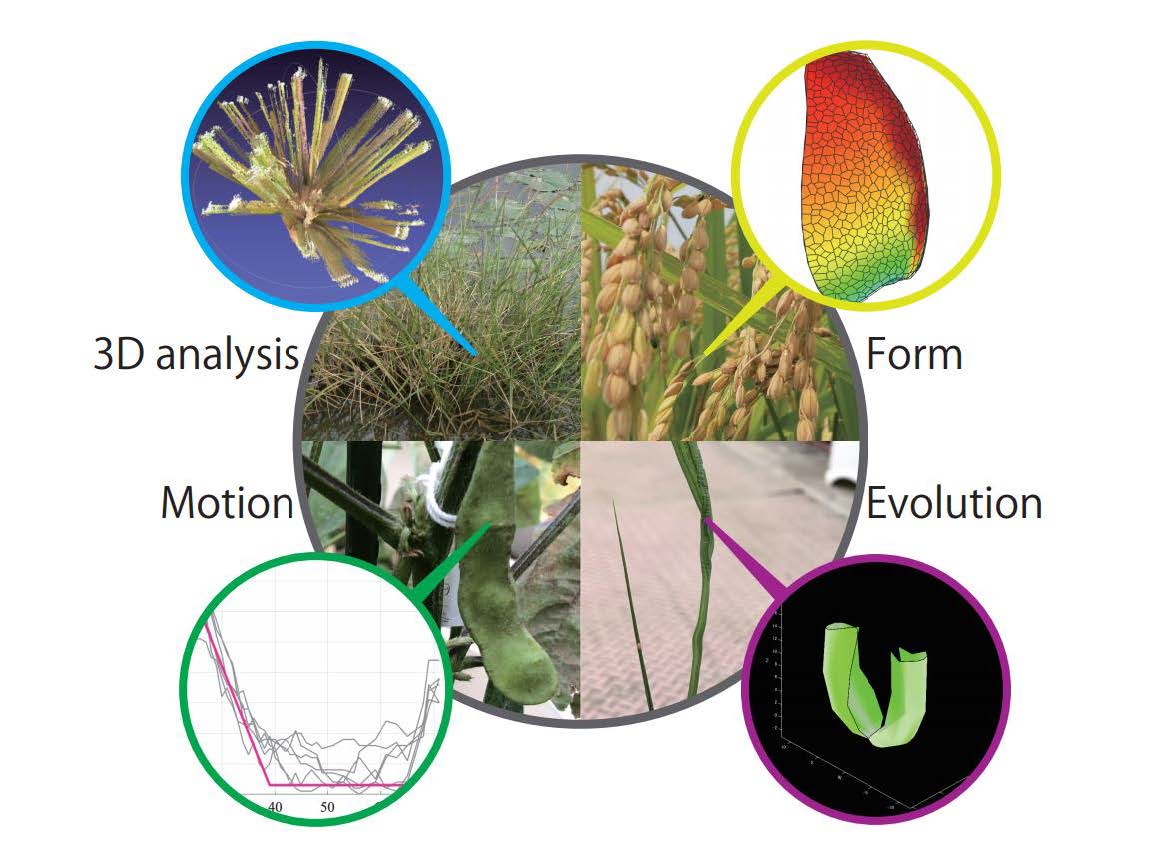
Rice production in Hokkaido
Hokkaido is a major producer of rice, boasting Japan’s largest crop acreage and yield. Most rice grown in Japan is from the Japonica variety, which has a rounder pill-like shape and stickier texture compared to the Indica or Javanica varieties.
Rice cultivation in Hokkaido has developed over the years by overcoming the harsh climate that includes cold temperatures and heavy snowfall. Since the variety called Kirara 397 debuted in 1989, breeding has been used to develop other types of Hokkaido rice that taste better and withstand the cold climate better. The Nanatsuboshi and Yumepirika varieties are highly acclaimed for their glossy appearance, sticky texture and great balance of sweetness. Both have received the Toku-A ranking, the highest possible, in taste tests performed by the Japan Grain Inspection Association. Currently, Hokkaido is cultivating rice in a more safe and secure manner by taking advantage of its colder climate to use less agricultural chemicals.
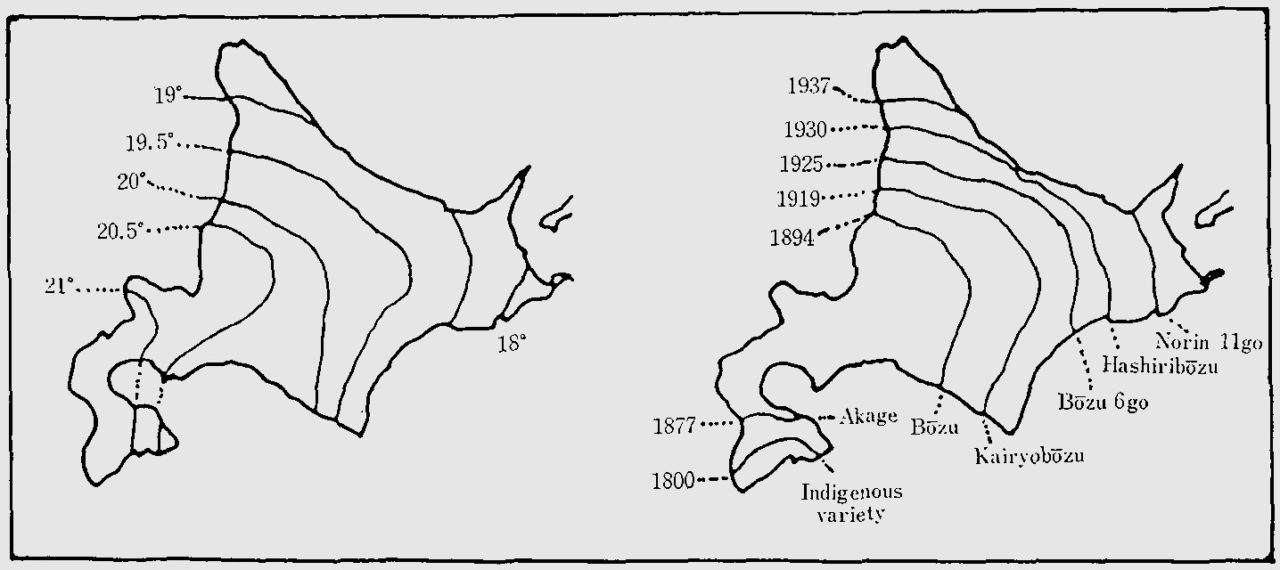
Summer average temperature lines in Hokkaido (left)
Years of progress for rice varieties to north area in Hokkaido (Right)
Members
-
Degree D. Agr. Specialty Plant Breeding and Genetics Charge (US) Department of Applied Bioscience | Plant Breeding Charge (GS) Division of Agriculture | Frontiers in Production Sciences | Unit of Agricultural Plant Science Research Theme Plant Breeding and Molecular Genetics
-
Degree D. Agr. Specialty Plant Breeding and Genetics Charge (US) Department of Applied Bioscience | Plant Breeding Charge (GS) Division of Agriculture | Frontiers in Production Sciences | Unit of Agricultural Plant Science Research Theme Plant Breeding and Genetics
-
Degree D.Agr. Specialty Plant Breeding, Genetics, and Development Charge (US) Department of Applied Bioscience | Plant Breeding Charge (GS) Research Theme Plant Genetics and Development Related with Plant Breeding
Researcher
- Shasha Wang
Research Title:Functional analyses of the Stabiliser genes that suppress transposon Tam3 activities of Antirrhinum majus
DC.3
- Kiwamu Hikichi
Research Title:Multifaceted analysis of plant organ morphodynamics using computational modeling: Cellular dynamics in soybean pod formation and structural analysis of a twisted leaf mutant in rice - Kayyis Muyadah Lubba
Research Title:Elucidation of the relationships between cold tolerance at booting stage and lipid metabolism in rice
DC.2
- Christabell Nachilima
Research Title:Uncovering the genomic basis of callus induction rate in rice anther culture using whole-genome data - Shuhei Okada
Research Title:QTL analysis of agronomic traits in tetraploid rice - Intan Widia Santika
Research Title:Genetic analysis of African rice for abiotic stress tolerance - Thet Htar San
Research Title:Analysis of grain content related traits in Asian and African rice varieties
DC.1
- Choi Kwan
Research Title:Molecular genetic study of hybrid sterility between O. sativa and O. glaberrima - Seiichiro Miura
Research Title:Study on cellular mechanisms regulating the three-dimensional morphogenesis of rice caryopsis
MC.2
- Yushi Juasa
Research Title:Gene expression analysis of cross-incompatibility specific to the A58 × A58S6 cross - Kosuke Miyamoto
Research Title:Identification of genes responsible for albino phenotypes in anther culture of rice - Tasuku Yoshida
Research Title:Identification of host factors localizing transposase of Antirrhinum majus transposon Tam3 to cytoplasm - Zhuohang Zhou
Research Title:Function analysis of qFDTH4 in the early heading riceof Hokkaido varieties
MC.1
- Shinnosuke Fujimoto
Research Title:Elucidation of the evolution and molecular mechanism of hybrid sterility genes in African rice (O. glaberrima) - Hang Ren
Research Title:Three-Dimensional Characterization and Structural Analysis of Rice Roots with a Focus on Aerenchyma - Narumi Kataoka
Research Title:Genetic analysis of agronomic traits of Kitaake RILs population - Yuka Konno
Research Title:Identification of genetic regions associated with anther culture efficiency in Indica rice and QTL analysis of traits in doubled haploid lines - Genta Mori
Research Title:Analysis of agronomic traits and QTLs in the segregating population of autotetraploid rice - Keisuke Shiozaki
Research Title:Analysis of the killer mechanism of hybrid sterility gene S13 found between Aflican wild rice O. longistaminata and Asian cultivated rice O. sativa - Minami Taguchi
Research Title:3D Imaging-based analysis of growth and cell division dynamics during leaf development in monocots - Daichi Ujiie
Research Title:Genetic analysis of heat tolerance in African rice (Oryza glaberrima)
BC 4
- Nao Sano
Research Title:Genome analysis of Zea mays using Nanopore sequencer - Yua Sato
Research Title:Study of differences between varieties based on three-dimensional growth analysis of rice grains - Kana Takashima
Research Title:Relationship between albino formation and plastid DNA degradation in rice anther culture - Masahiro Yamamoto
Research Title:Utilization of genome editing in development of the tetraploid rice
BC 3
- Anna Kawakami
- Harunori Kirimura
- Miu Yamamoto
- Yuika Okada
- Kosei Orui
